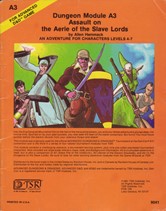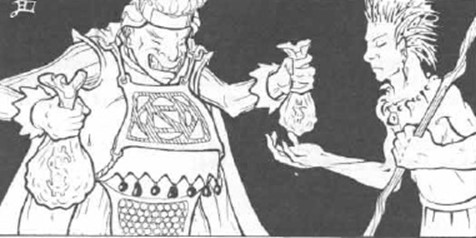 After the first two modules in the series, it is a pleasant surprise to consider Assault on the Aerie of the Slave Lords. This is a module that rather exceeds the design of what has come previously. The first part of the module is the fifth of five opening tournament rounds, and involves the heroes making their way to the Aerie through a set of “caves” – although past the initial cave most are actually man-made. As it stands, it’s a rather forgettable dungeon: quite linear, and notable primarily for the introduction of the “stone roper” or “storoper”, which I have a nostalgic love for, despite it’s very cruel, no-saving-throw domination power.
After the first two modules in the series, it is a pleasant surprise to consider Assault on the Aerie of the Slave Lords. This is a module that rather exceeds the design of what has come previously. The first part of the module is the fifth of five opening tournament rounds, and involves the heroes making their way to the Aerie through a set of “caves” – although past the initial cave most are actually man-made. As it stands, it’s a rather forgettable dungeon: quite linear, and notable primarily for the introduction of the “stone roper” or “storoper”, which I have a nostalgic love for, despite it’s very cruel, no-saving-throw domination power.
It is with the city of Sudenham, held within a volcanic crater, that the adventure becomes interesting. The second section of the adventure details the city: all 68 encounter areas of it. Yes, it’s fairly small for a town, but there’s enough there for a DM to flesh out and use as the setting for his own adventures in the town. For tournament purposes, most of the town is unused with most of the businesses listed merely as “closed”, although their identity is revealed; in non-tournament play, the DM can create a living, breathing city. A player’s map detailing the locations of the buildings but not their identities is provided with the adventure.
Notable encounters in the town include a House of Ill Repute where five rakes insult the characters and try to provoke them into a fight, and an Assassin’s Guild that, though it takes no part in the adventure, has a number of notes on what would occur if anyone were to commit a “freelance” assassination and remain in the city afterwards! A City Encounter table and notes on taverns, moneychangers and guards round out the section. Nothing is gone into in great detail, but I find the result greatly appealing; if you want to know the minimum needed for a DM to bring a city location to life, this is it! (It’s very likely some DMs will be very frustrated by what is given here and go looking for the Village of Hommlet).
In tournament play, the group just have to find a passage through the sewers that leads to the Slave Lords in their Aerie.
The adventure proper returns in the third section, which is a dungeon-crawl through the sewers and catacombs beneath Sudenham. As with previous dungeon-crawls in this series – and with the first section of this adventure – the encounters are designed to challenge the adventurers and provide some variety: thus, the encounters include a killer mimic, a minotaur to ambush the party, and a pit trap holding a gelatinous cube!
Eventually this all leads to an encounter with the five of the nine Slave Lords proper, who have been observing the party’s progress through a crystal ball. In the original tournament adventure, the group are overcome by sleeping gas at this point, and will be dumped into the dungeons of the final adventure in the series. (A4: In the Dungeons of the Slave Lords), but in regular campaign play you can play out the combat. If the party dies in this combat, the Slave Lords raise the party to interrogate them, as they are understandably interested in discovering how much they and their sponsors know, and then dump them in A4. If the party wins, then going up into the citadel will mean they’re captured (and once again thrown into the dungeons), but if they decide to go back the way they came, then you’re on your own (but it’s really likely they’ll end up captured and put in the dungeons. Do you see where this is going?)
The artwork of this adventure – by Jeff Dee, David S. LaForce, Erol Otus, Jim Roslof and Bill Willingham – wanders between the average to the quite good. The book includes some memorable pieces of art, particularly one of a halfling offering a drink to a fighter.
I very much like Assault on the Aerie of the Slave Lords; it is still hampered by its original tournament background, but there are enough good ideas in the adventure to make it one of the more memorable adventures of early D&D.
At the time of writing, the adventure is not available in PDF form, but can be found in a reprint edition.

